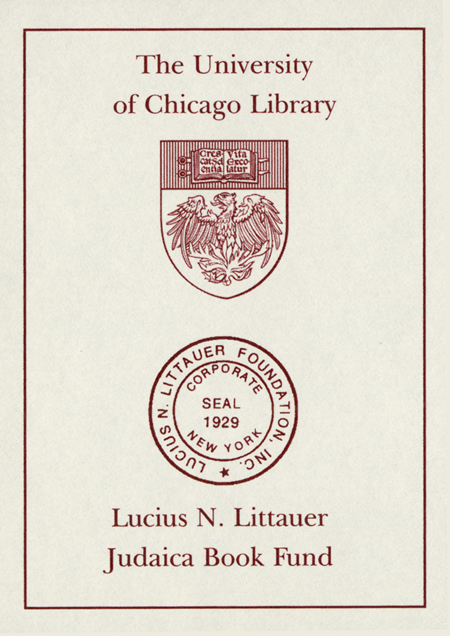The world's oldest alphabet : Hebrew as the language of the Proto-consonantal script /
Saved in:
| Author / Creator: | Petrovich, Douglas, author. |
|---|---|
| Imprint: | Jerusalem : Carta, 2016. ©2016 |
| Description: | xvi, 262 pages : illustrations, maps ; 24 cm. |
| Language: | English |
| Subject: | |
| Format: | Print Book |
| URL for this record: | http://pi.lib.uchicago.edu/1001/cat/bib/10953184 |
Table of Contents:
- Introduction
- Preface
- Acknowledgments
- List of Maps and Figures
- 1. Background Matters to the Proto-Consonantal Inscriptions
- The Place of the First Alphabet among the Earliest Writing Scripts
- The Proper Semitic Language of the Proto-Consonantal Script
- The Path that Led to Identifying Hebrew as the Proto-Consonantal Script
- The Thesis and Structure of the Present Work on Early Alphabetic Inscriptions
- The Conventions Used for the Study of the Following 16 Inscriptions
- 2. The Inscriptions of the Period of Egypt's Middle Kingdom
- The Caption on Sinai 115
- Background to the Inscription
- Paleographic Decipherment
- Translation and Orthography
- Potential Historical Value
- Sinai 377
- Background to the Inscription
- Paleographic Decipherment
- Translation and Orthography
- Potential Historical Value
- Wadi el-Hôl 1
- Background to the Inscription
- Paleographic Decipherment
- Translation and Orthography
- Potential Historical Value
- Wadi el-Hôl 2
- Background to the Inscription
- Paleographic Decipherment
- Translation and Orthography
- Potential Historical Value
- Lahun Bilingual Ostracon
- Background to the Inscription
- Ceramic Evaluation
- Paleographic Decipherment
- Translation and Orthography
- Potential Historical Value
- Sinai 376
- Background to the Inscription
- Paleographic Decipherment
- Translation and Orthography
- Potential Historical Value
- 3. The Inscriptions of the Period of Egypt's New Kingdom
- Turquoise Mines at Serâbit el-Khâdim
- Sinai 345a and Sinai 345b
- Background to the Inscriptions
- Paleographic Decipherment
- Translation and Orthography
- Potential Historical Value
- Sinai 346a and Sinai 346b
- Background to the Inscriptions
- Paleographic Decipherment
- Translation and Orthography
- Potential Historical Value
- Sinai 349
- Background to the Inscription
- Paleographic Decipherment
- Translation and Orthography
- Potential Historical Value
- Sinai 351
- Background to the Inscription
- Paleographic Decipherment
- Translation and Orthography
- Potential Historical Value
- Sinai 353
- Background to the Inscription
- Paleographic Decipherment
- Translation and Orthography
- Potential Historical Value
- Sinai 357
- Background to the Inscription
- Paleographic Decipherment
- Translation and Orthography
- Potential Historical Value
- Sinai 360
- Background to the Inscription
- Paleographic Decipherment
- Translation and Orthography
- Potential Historical Value
- Sinai 361
- Background to the Inscription
- Paleographic Decipherment
- Translate on and Orthography
- Potential Historical Value
- Sinai 375a
- Background to the Inscription
- Paleographic Decipherment
- Translation and Orthography
- Potential Historical Value
- Sinai 378
- Background to the Inscription
- Paleographic Decipherment
- Translation and Orthography
- Potential Historical Value
- 4. Concluding Thoughts
- The Historical Credibility of the Account of Israelites in Egypt
- The Dating of the Corpus of Proto-Consonantal Hebrew Texts
- General Findings of the Present Study
- The Inventors of the Proto-Consonantal Hebrew Script
- The Value of the Proto-Consonantal Hebrew Corpus to Biblical History
- The Identification of the Golden Calf/Heifer in Exodus 32
- Appendices
- Appendix 1. The Original 22 Letters of the PCH Alphabet
- Appendix 2. The Additional (Non-Original) Five Proto-Alphabetic Letters
- Appendix 3. Declining and Parsing Guide for ME and PCH Words
- Appendix 4. Chronology of Relevant Ancient Egyptian Dynasties
- Abbreviations
- References
- Index

